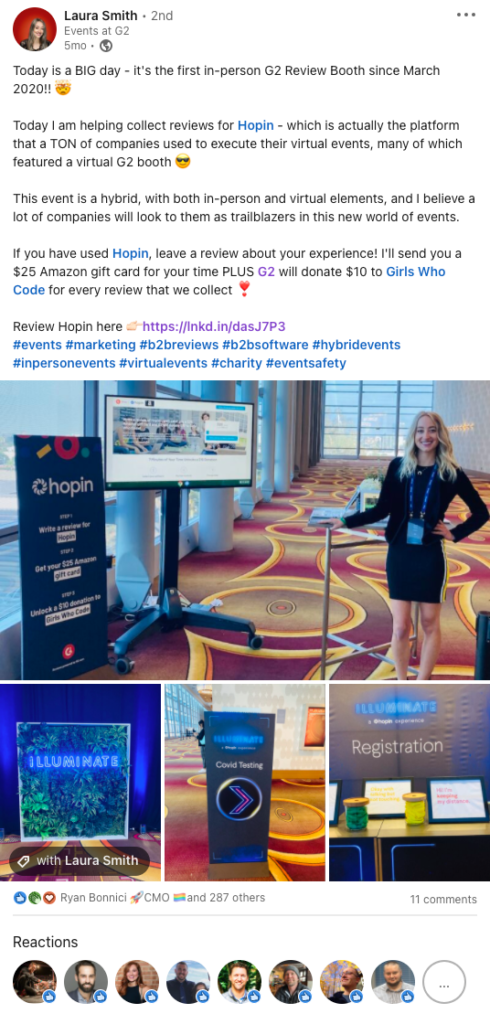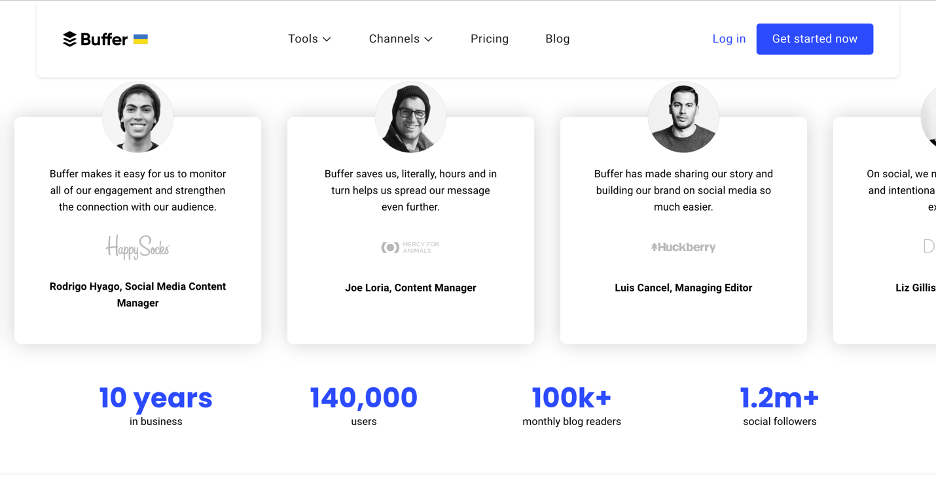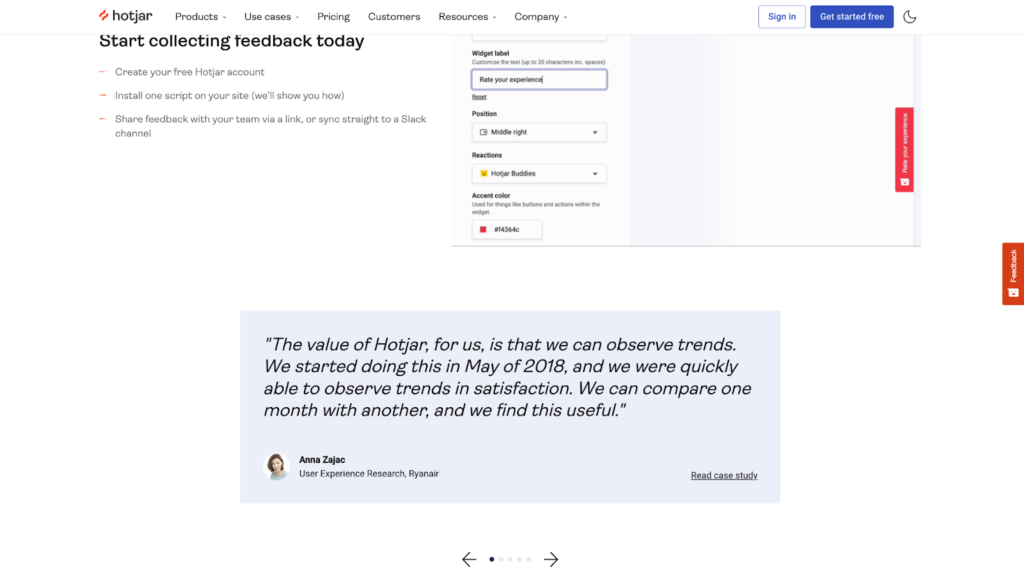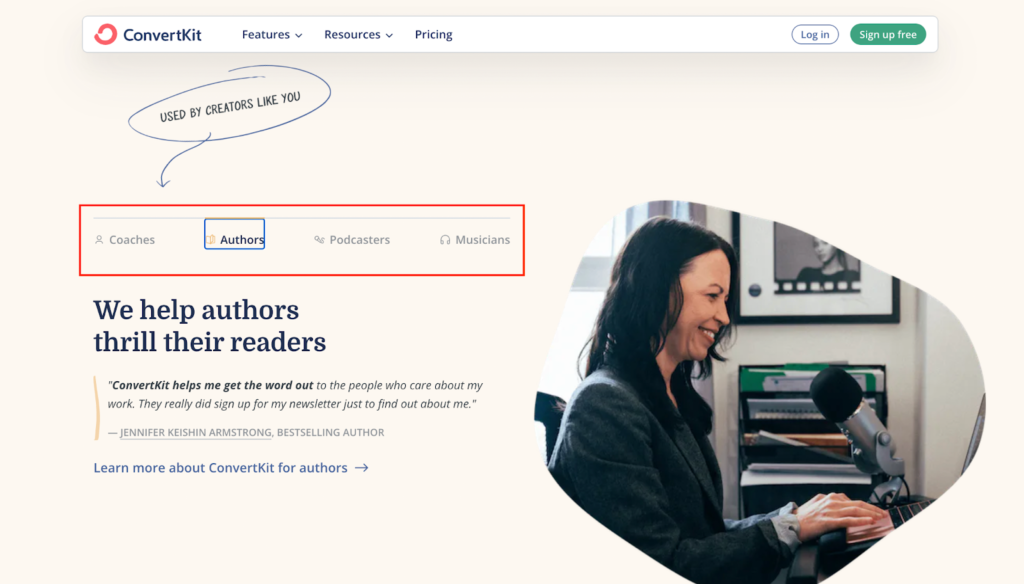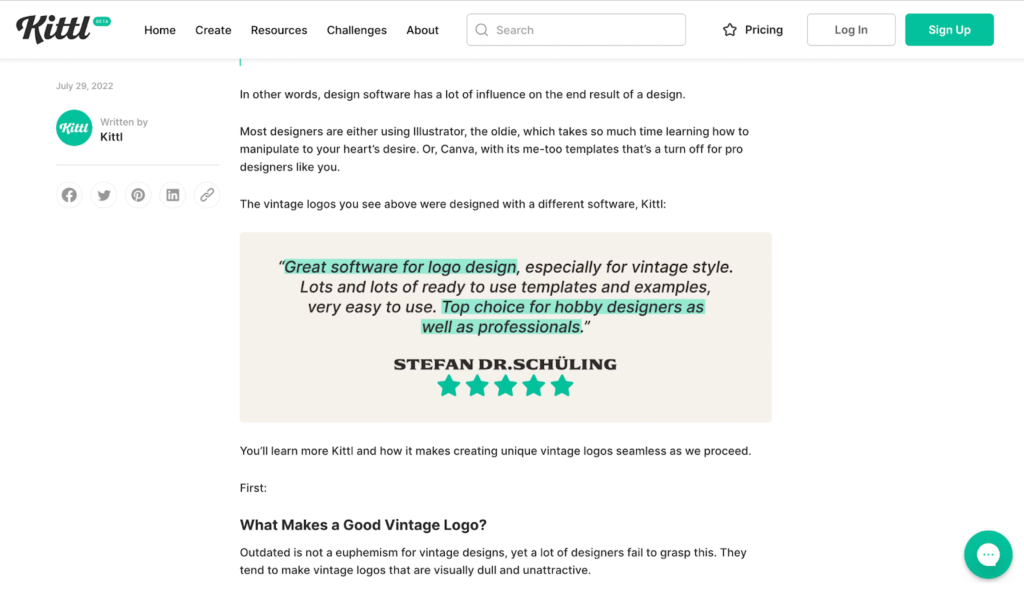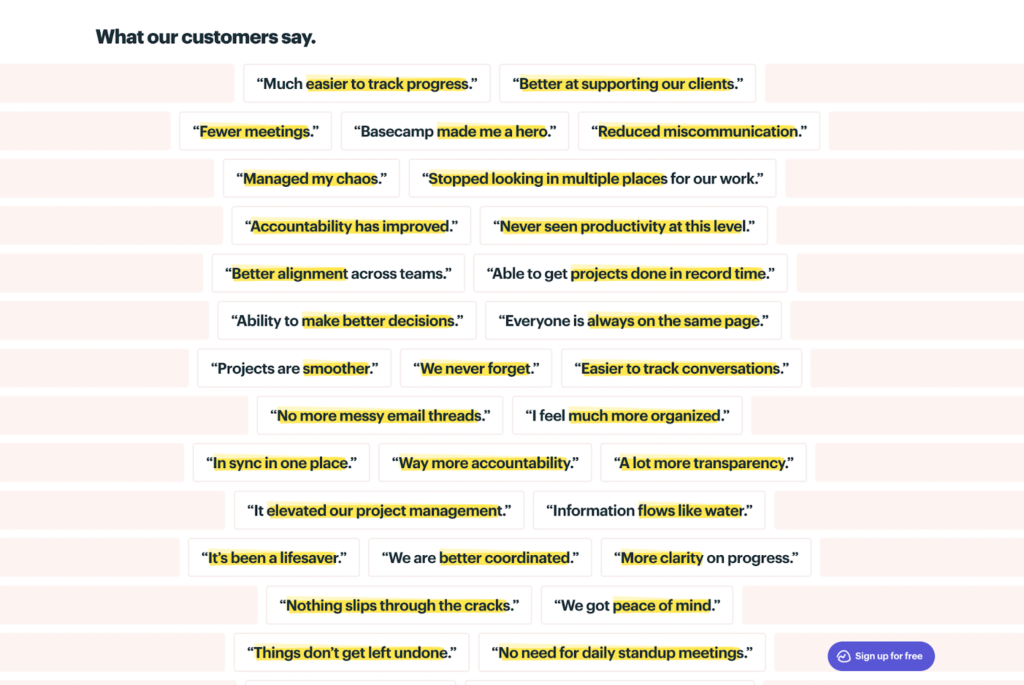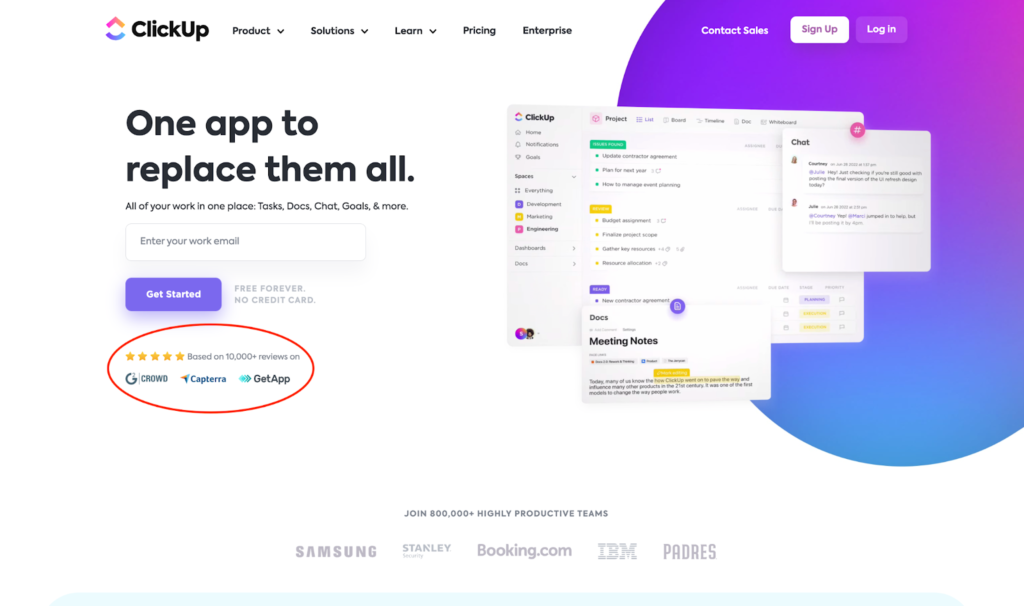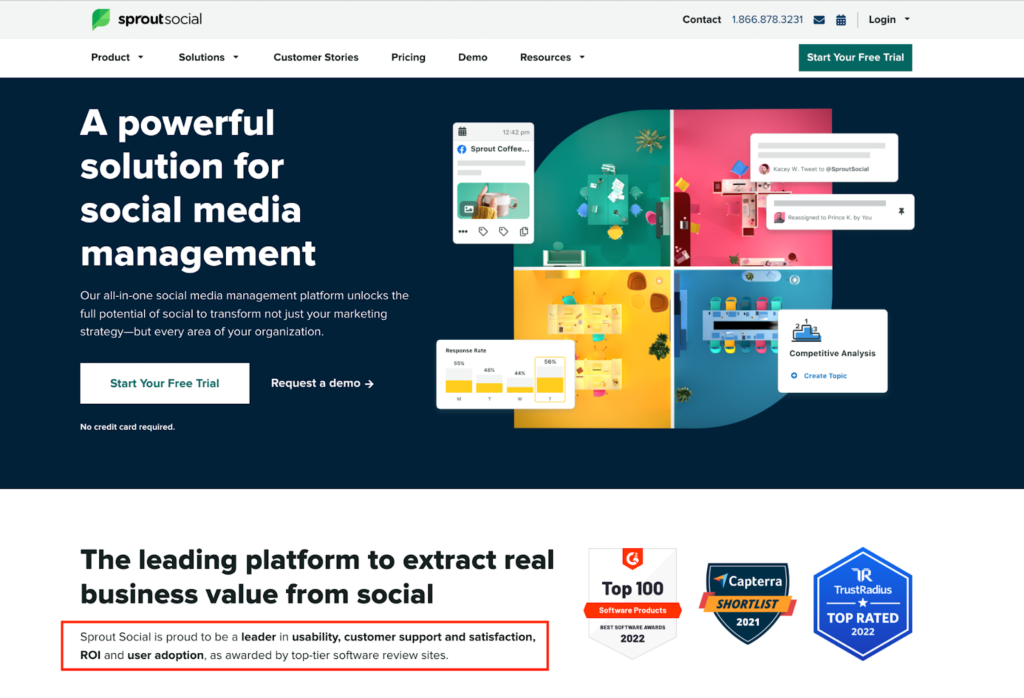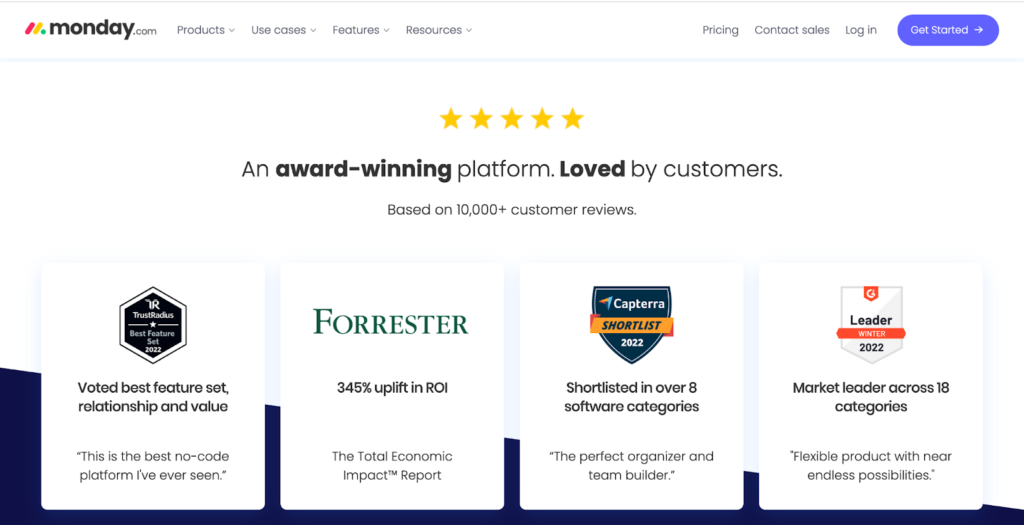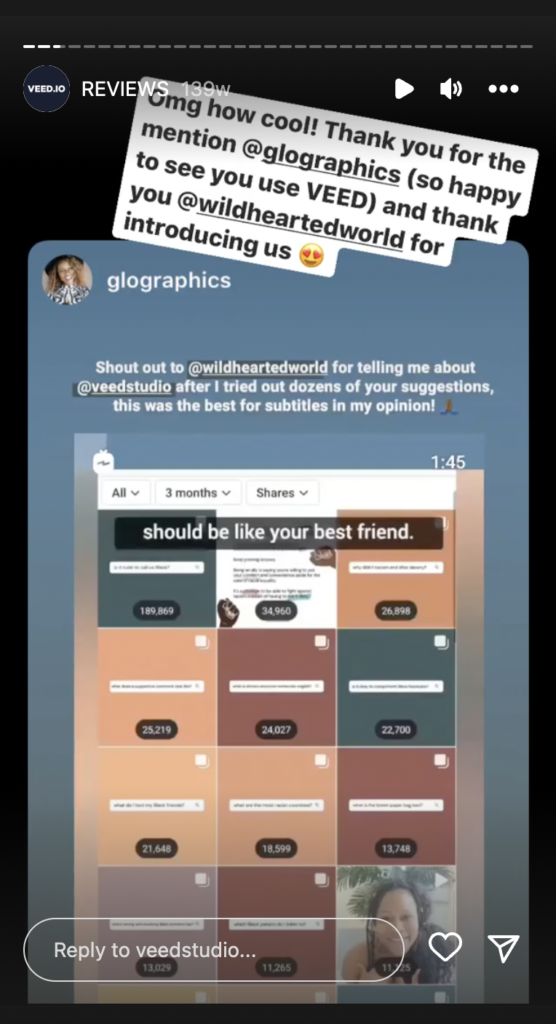B2B buyers across the board reference checking review sites as their first step after identifying a need for making purchase decisions.
In fact, nearly 3 in 4 SaaS buyers use social proof when evaluating software to buy according to the same source. 1 in 3 buyers also relies on online reviews when selecting software.
Aside from a buyer’s own experience, they trust no one or no resource more than their peers’ experience with your SaaS tool.
This makes it clear: getting reviews for your B2B SaaS product isn’t something to put on the back burner. If anything, generating reviews can be the game-changer that drives your business to success.
The question now is: how can you get reviews of your SaaS solution? Let’s walk you through eight proven ways to generate B2B SaaS reviews. Altogether, we’ll touch on the following in this guide:
The Importance of B2B SaaS Reviews
Online reviews help you gain potential buyers’ trust, encourage sign-ups, and give you insights on improving your product among other benefits.
Let’s look at these advantages in detail:
Grow social proof
Customer reviews grow potential users’ trust in your software as they give them a rundown of their peers’ full experience of using your tool.
Keep in mind that 68% of buyers involve your sales team only toward the end of their purchase decision. And only 26% trust your marketing collateral.
This makes reviews an influential channel for not only gaining your potential buyers’ trust but also convincing them to buy from you.
Build a reputation for yourself
As more and more buyers talk about a specific feature or two about your product in their reviews, you can also quickly build a name for yourself among your target audience.
For instance, becoming known for your proactive customer support or as an easy-to-use tool among competing software.
Develop a user-centered tool
Online SaaS reviews also offer insights into your customers’ minds on ways you can improve your product.
To this end, make sure you carefully study reviews that specify what your users like, dislike, or struggle with when using your product. If there’s a complaint that repeatedly comes up in your reviews, take action to correct it.
Making changes based on customer feedback is also an effective way to tell customers you value their feedback and have taken steps to rectify the problem they pointed out.
In turn, this approach reduces churn by helping you create a product that retains users.
Encourage new user sign-ups
Online reviews on your SaaS tool are among the top four most influential sources guiding buyers in their purchase decisions (the other three being: industry experts, professional network/colleagues, and internal influencers).
Interested buyers use SaaS reviews to verify what they’re looking for in a product such as ease of use or a specific benefit that others like them may have achieved using your tool.
They also pay attention to who has written the review to better compare their business requirements with the reviewers and understand how your product will be useful to them.
All these factors (positive experiences that reviewers share, improved search ranking, and earning your target audience’s trust) encourage sign-ups.
Dive deeper: Why Online User Reviews Matter In B2B SaaS.
How to get reviews for B2B SaaS product
For a quick overview, here are eight B2B SaaS review generation tactics you can use today, followed by the details:
- Ask your customers directly
- Use NPS surveys
- Create an automated email review request
- Outsource review generation to a review site
- Make a personalized ask in your customer newsletter
- Collaborate with your customer-facing teams
- Use a customer advisory board to source product reviews
- Leverage social media to generate B2B SaaS reviews
1. Ask your customers directly
71% of buyers are willing to share feedback for products they’ve purchased. Although there are many ways to get them to share feedback, your best bet for driving reviews for your SaaS tools is simply asking users.
Here are four ways to go about sourcing direct customer reviews:
Personal Request
Begin with directly asking for reviews from your users when you’re speaking with them.
In B2B SaaS, there are 1:1 relationships between a customer-facing employee and a customer user. Multiple people at your company — Customer Success Managers, Account Managers, and Sales reps — may have a relationship with your users. They can assess when to ask for the review, how to ask for it, and pick the right channel, whether it’s by email, on Zoom, in Slack, or elsewhere. Companies of all sizes and resources can use this approach. For many, it’s the easiest way to start getting reviews.
Request reviews at customer-only events you host
Another good time to ask for reviews is at the events you host for your customers. These can be in-person, virtual, or hybrid events.
Melody Leatherbury, the Customer Marketing Manager at Webex Events, used review booths paired with a digital scavenger hunt at a hybrid conference they hosted to drive 250 reviews in only three days.
Melody shares her process:

“At the event, customers could participate in a digital scavenger hunt hosted in our customer advocate portal and receive reward points for writing a review either at the review booth or on their personal phone/laptop. Reward points could then be traded in for a gift card or another reward in the advocate portal.”
Melody Leatherbury, Customer Marketing Manager at Webex Events
“I worked with my planning team to create a review booth with six laptops and highchairs. To incentivize customers to write a review, I gave away branded socks as swag and partnered with G2 to make a $10 charitable donation for each review written. Customers loved the charitable donation and the swag.”
Set up review booths at in-person user conferences you host
If you can host user conferences, you can also set up review booths to generate reviews there.
Hopin, for example, paired up with G2 to set up a review booth at their 2021 hybrid event, Illuminate — incentivizing 10,000+ attendees with Amazon gift cards and donations to a non-profit organization, Girls Who Code.
In July 2021 (the month of the event), Hopin drove 48 G2 reviews, well above their monthly review average. This review booth helped contribute to Hopin’s +850 G2 reviews all-time, leading to its 2nd place rank in the Virtual Event Platform category on G2.
Send in-app notifications
Lastly, meet users where they are at — your tool. Keep in mind though: only send in-app review requests after a user has engaged with your app.
This allows you to give them ample time to use your tool to leave meaningful feedback. It also doesn’t interrupt them when their learning to use your software.
Gong leverages this tactic to generate their tool reviews — incentivizing users to write a review in exchange for a $10 gift card.

2. Use NPS survey to gather reviews
Next up, generate reviews using Net Promoter Score (NPS) surveys — surveys that tell you how likely your customers are to recommend you to their network.
The Sendible team employed this B2B SaaS review generation tactic, according to their Founder, Gavin Hammar, who writes:

"We used NPS surveys to identify our promoters. Then, we had an automated email campaign that would email our promoters asking them to leave us a review on G2. At first, we tried to incentivize them using gift vouchers but that didn’t work. So, we experimented using swag and that drove tons of reviews! Every reviewer would receive a Sendible hoodie, which not only acted as an incentive, but it was great for brand awareness too!"
Gavin Hammar, Founder at Sendible
Besides incentivizing your promoters with company swag, you can also offer incentives like a month’s free subscription, an Amazon voucher, or a charity donation.
That said, make sure your email requesting the review reduces friction. That is: make it easy for reviewers to share their feedback by reducing the steps involved in the process.
Otter emails its users for feedback after completing the first task using their tool. Here’s the email they sent me after I generated my first transcript:
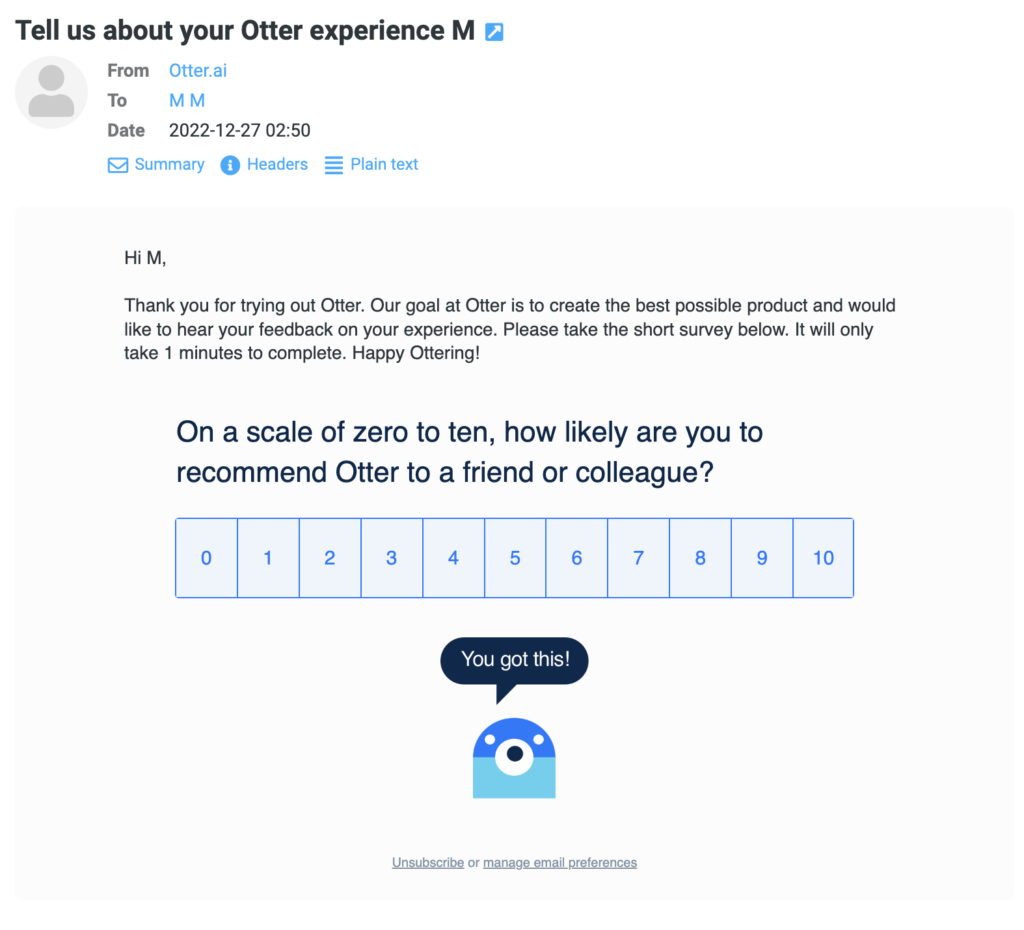
Note that the email is short, to the point, and sets the right expectations by highlighting that it’d only take me a minute to share my feedback. These are traits of effective B2B review request emails as they indicate you respect customers’ time by keeping the message concise.
Lastly, make sure your automated email doesn’t sound robotic. Instead, make a personalized ask that sounds human. Also, don’t forget to add a brief note explaining how their review will help you (creating a better product, introducing our tool to your peers, and so on).
Want to learn more about using NPS surveys to generate reviews? Here’s the step-by-step playbook ChurnZero used to increase their TrustRadius reviews by 49% in three months using this tactic.
3. Create an automated email review request
Send out requests for reviews after your users:
- Achieve a milestone using your tool
- Complete their first task using your product
- Show a record-high or significant use of your tool

This way, customers who use Capterra wouldn’t need to take the extra step to sign up for G2 to leave a review. Instead, they can easily use the CTA button relevant to them and leave a review in just a few clicks.
Dive Deeper: 30 Best Software Review Request Templates: A Round-Up.
You can also automate your review request emails to go out to users after a time-based trigger such as them being your customer for 90 days or after they renew or upgrade your subscription.
4. Outsource review generation to a review site
76% of buyers think that SaaS review sites are trustworthy or highly trustworthy. As a result, 1 in 2 buyers uses them to educate themselves on the benefits and risks of purchasing a specific product and for making more informed confident purchase decisions.

But where you can encourage users to write you a review on these sites, you can also pair up with the review site to generate SaaS reviews. This tactic saves you time and reduces work on your plate, though note that the conversion rate is often low than if you asked directly.
All you need to do when collaborating with a platform like G2, for example, is to send them a list of your users to ask for reviews. The trusted third-party review site will then send a three-email sequence to these users to request reviews.
Reachdesk used this strategy to become one of the fastest-growing products on G2. They even made it to the 18th position on G2’s 2022 Best of Software list. Anna Nørager Deigaard, Reachdesk’s Senior Campaign Executive shares:

“We collaborated closely with our Customer Success team to ensure we encouraged clients to leave their reviews and ran campaigns both directly through G2 and by ourselves, and on different platforms to test out what worked best. As we’ve grown as a company and on G2, our strategy has shifted to keeping a consistent stream of high ratings to up our overall rating, while maintaining our leader placement in all of our respective categories.”
Anna Nørager Deigaard, Campaign Manager at Reachdesk
5. Make a personalized ask in your customer newsletter
Start with identifying which of your customers are regularly opening and engaging with your emails. Create a segment of these active users and send them a newsletter issue with a personalized review request.
For instance, tell them how their review will help you. You can also feature some positive reviews to encourage subscribers to leave their thoughts.
Alternatively, add a call for review toward the end of your regular newsletter as FullStory does here:
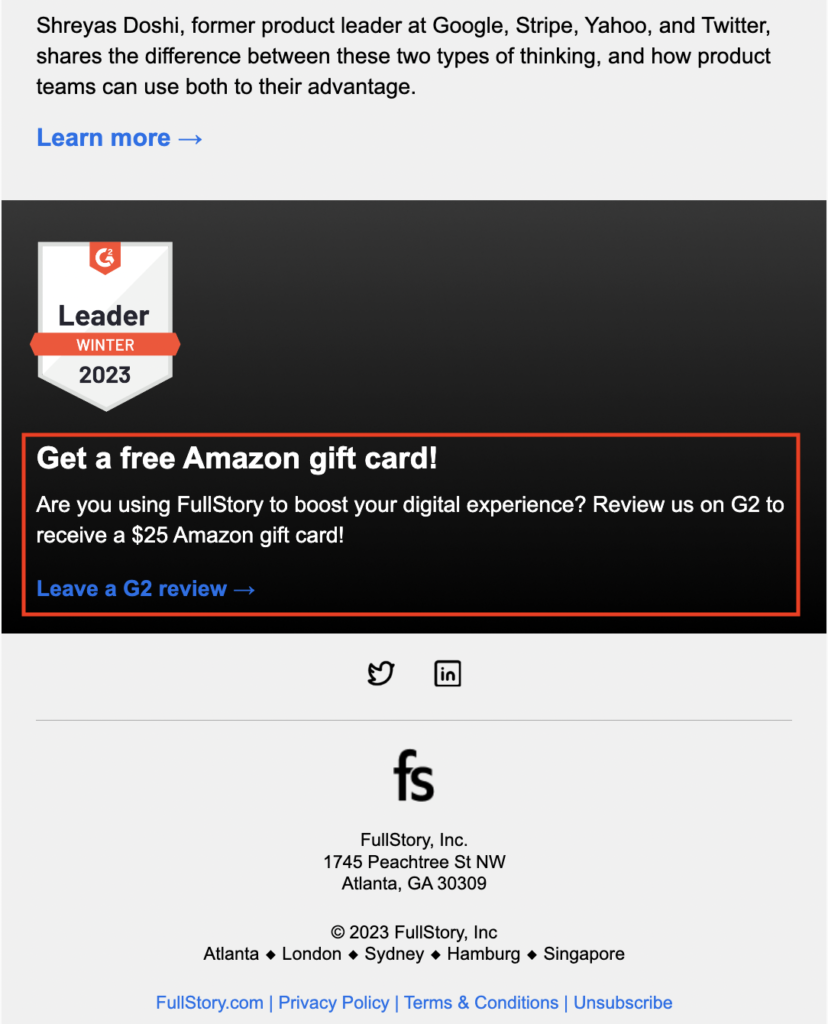
6. Collaborate with your customer-facing teams
At PrimoStats, a small but enthusiastic team, Shayla Price, the Founder shares:

“We get our online reviews via customer support emails. The reviews come naturally in those conversations. Then, we ask if we can use that statement as a review/testimonial on our website.”
Shayla Price, Founder at PrimoStats
Josh Ho, Founder and CEO of Referral Rock notes they also use their customer-facing team to generate reviews. “We put [generating reviews] as goals for our services team and they do outreach at peak moments of joy.”
The CTA you use in emails that customer-facing teams send must come off as natural to encourage responses. A few ideas to test include phrases like: “how was your experience,” “share your thoughts,” and “leave a review.”
For Shayla’s team too, the CTA they used made all the difference in how many reviews they source this way. Shayla comments, “We tried using questions, but people ignored them. Framing it as ‘describe your experience’ is [however] getting more responses.”

7. Use a customer advisory board to source product reviews
A Customer Advisory Board (CAB) is a group of customers that you meet with regularly to source product feedback.
You can use it to source more online reviews for your tool. However, using a CAB to generate SaaS reviews is more about the reviews’ quality than quantity. Meaning: you can’t scale this tactic to generate tons of reviews in a short span of time. Instead, use it to drive high-quality, specific customer feedback as PartnerStack did.
Joe Kevens, the Founder of B2B SaaS Reviews and Director of Demand Gen at PartnerStack, shares he has worked with PartnerStack’s CAB to produce a video review for their solution. In his words:

“After intereviewing some of our CAB members on ad messaging, I kept in touch with one member, James Urie, Senior Partnerships Manager at Close CRM, who is a great advocate for PartnerStack. When we needed a video review to optimize our G2 profile, I sent James a Slack message asking if he’d be up to provide us with one, to which he said he’d be happy to.”
Joe Kevens, Director of Demand Gen at PartnerStack and Editor-In-Chief of B2B SaaS Reviews
8. Leverage social media to generate B2B SaaS reviews
You can both find and feature user reviews from social media and/or use them to generate more reviews.
The key to doing it well, though? Social listening. Pay attention to what users are saying about your tool on social media, as Airtable does here:
Scripting owns are ❤️. Learn how you can remove redundant tasks from your workload: https://t.co/3qJWnPyiC9
— Airtable (@airtable) January 13, 2023
s/o @rachidakiki pic.twitter.com/XDsrVJOUYs
You can also take this a step further and reach out to reviewers, incentivizing them to share a detailed review on a third-party site like G2.
Dive deeper: 10 Top Review Tips from B2B SaaS Pros.
How and where to use SaaS reviews (with examples)
Now that you know how important SaaS product reviews are and ways you can get them for your tool, let’s take you through the different review types and how to use them:
1. Quotes and testimonials
Quotes and testimonials tend to be the most popular types of reviews.
They’re also easy to read (thanks to their brevity), therefore, serving as quick bites of social proof that spark potential customers’ interest in your tool.
Not to mention, you can easily share quotes and testimonials — both on your social media channels and on your homepage. You can do so as a carousel with customer quotes on your home page as Buffer does, for instance:
Or you can feature quotes on other pages like your feature pages as Hotjar does. When sharing testimonials on feature pages though, make sure the quote specifically speaks about the feature, so the review placement is relevant and makes for convincing social proof.
Another idea for sharing customer quotes and testimonials: use them to convert different user personas.
ConvertKit, for example, targets different user groups such as authors, podcasters, and musicians. To ensure they’re sharing reviews specific to each group, their homepage features testimonials from customers from each buyer group. Here’s how:
Yet another way to use quotes is to include them in your blog content. Kittl does this well:
You can also include quotes from the case studies you write in your blog content.
Lastly, you can also one-line quotes or pick out one-liners from your customer testimonials to create a wall of social proof on your homepage. Basecamp has done this on their homepage — a smart move to highlight the most outstanding praise in an easily readable way.
2. Reviews on third-party review sites
Recall that reviews on trusted third-party software reviews sites like G2 and TrustRadius grow your credibility, given buyers turn to them as a resource in their buying process.
Also, reviews on these sites can grow your business, as they did for Sendible. Their Founder, Gavin Hammar, shares:

“The real value came from having those reviews on G2. Our prospects naturally turned to review sites before deciding which platform to choose. And when they saw us listed as one of the top tools in our category, their level of trust was so much higher than if they had just discovered us organically. Because of our positive reviews, we were prominently featured in G2’s review grid and seasonal awards which helped us generate lots of new business.”
Gavin Hammar, Founder at Sendible
In short, when interested buyers come across your product’s positive reviews, their trust in your product only grows.
The best part? You can leverage your overall star rating from these sites and feature them on your homepage for a persuasive dose of social proof.
ClickUp, for instance, shares their overall third-party platform rating in their hero image (they also include logos of other companies using their tool to double the social proof – building trust by leveraging the credibility of other businesses using their software).
If you win specific awards from these review sites, you can share them on your homepage too as SproutSocial does, featuring the awards (immediately after the hero image):
You can also take inspiration from Monday.com and feature the awards you win with customer quotes:
Segment takes this a step further by sharing their G2 rating and other results with their email list (see screenshot below). You can do the same to nurture and increase interested customers’ trust in you:

Lastly, you can link to your G2 reviews in your emails too. Gavin shares how they did this for Sendible: “We had the sales team include a link to our G2 reviews in their emails to prospects — another great way to build trust.”
3. Reviews on social media sites
As with testimonials on review sites, social media reviews tend to be authentic, therefore, more believable.
So make sure you make the most of them by retweeting them as Trello does:
Been getting my organise on ahead of 2023. I forgot how much I love @trello 💪 pic.twitter.com/MA27HEH5Wg
— 𝗝𝗼𝗻𝗻𝘆 (@jonny_bass) November 17, 2022
Another idea is to create a Story highlight so there’s a dedicated corner for reviews as VEED does:
Another way to leverage social media reviews: screenshot and share the feedback on your site as Zapier does:
4. Customer stories and case studies
Lastly, create detailed walkthroughs of exactly how your software helps other users and the results it drives for them.
These customer stories are uber-helpful for triggering readers’ imagination, helping them visualize the results they can drive using your software, therefore, persuading them to use your tool.
Miro does this well:
If your case studies successfully capture the exact numbers-based results you’ve driven from customers, you can feature them on your homepage too. Monday.com does this. They’ve created a results-focused carousel featuring customer stories.
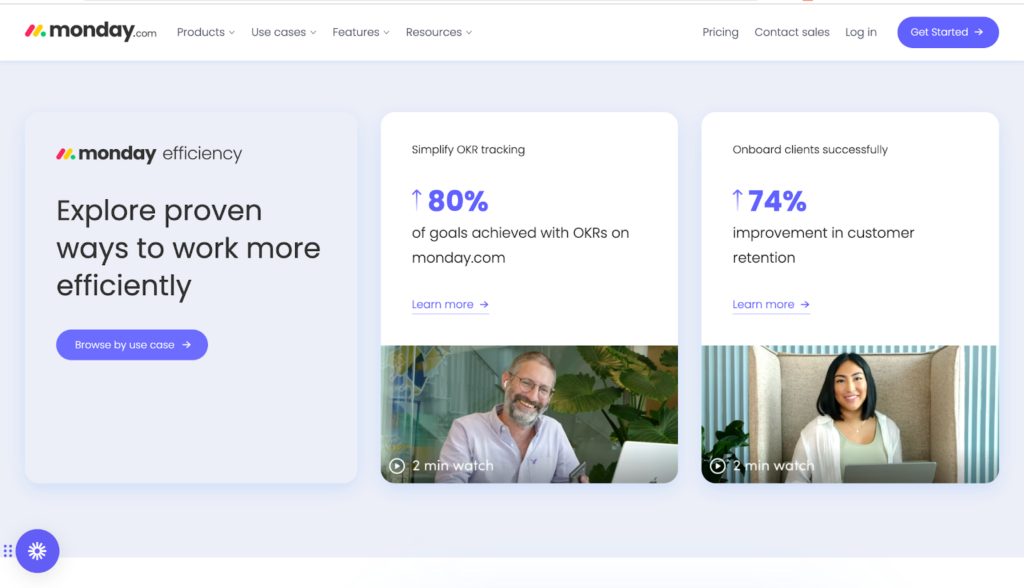
Both these ways of sharing customer success stories not only help you feature social proof on your homepage but also work as magnets attracting interested buyers to click and read the full story. This, in turn, grows your conversion rate.
Get reviews for your B2B SaaS product
To summarize, generating B2B SaaS reviews can be challenging but not impossible.
Simply start by picking 1-3 of the tactics we’ve shared above and stick with them. Don’t forget; it’s important you test things like your messaging, CTA wording, and the timing for review requests. All these small details leave a meaningful impact, so make sure you’re testing and optimizing regularly.
Lastly, because reviews can help you earn potential buyers’ trust and encourage them to choose your tool, be sure to feature them prominently in your emails, homepage, blog content, and social media.
Want to learn more about how you can leverage reviews? Dive into this comprehensive guide on leveraging online reviews in B2B Marketing and Sales.
Authors
-
-
I'm the Founder and Editor-In-Chief of B2B SaaS Reviews. I'm also the Director of Demand Generation at PartnerStack, the #1 platform purpose-built for partner management and affiliate marketing in B2B SaaS. Before PartnerStack, I worked for other go-to-market B2B SaaS companies: Influitive (Advocate Marketing designed to generate more reviews, references, and referrals), LevelJump (Sales Enablement) (acquired by Salesforce) and Eloqua (Marketing Automation) (acquired by Oracle).


